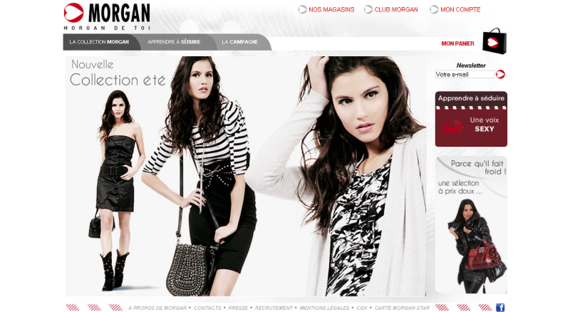66 Famous Fashion Websites for your Inspiration
Here is a list of inspirational web designs from the fashion design industry. Most of them use Flash to create a "fashion experience" when visiting their site and some are exceptionally innovative. Although almost all of them have a minimalistic design, the individual style gets reflected succes...
Read More...
Touch The Future: Create An Elegant Website With HTML 5 And CSS3
Demo | Download
I’m sure that who chooses to work as web designer makes a choice of heart, a choice of love. He/she decides to bet any given day on his creativity and his ability of producing an idea and of making it tangible, visible and perceptible for all. These crazy men have my respect. But, also when the creative side is very important for a work, there exists a logical (and technical) part in all creative process.
There are some moments and situations in which the creative mind needs an analytical method to achieve the objective, that is, for us, the creation of a well-done website.
In his article on Design Informer titled “Web Design Iterations And Algorithm,” Adit Gupta explains how we can approach a web design work and how a website project can be processed in a number of iterations following a main algorithm. Well, generally it’s just how Adit has described.
Our brain works well, in order to solve a big problem, if we can divide the main issue in N operations that solve N little difficulties, and the total sum of these N little steps provides the solution for our big problem. Perfect, ‘Houston, we have a big problem!’ We should create a working web design. Actually the common routine requires the following main steps:
- Step 1: understand the theme and the topics of the website and decode the client’s requests
- Step 2: choose the right style and sketch your ideas
- Step 3: draw a clean and clear wireframe to summarize the structure of the website
- Step 4: design the website (in pixels) through an image editor, like Photoshop, to create a real-scale mockup
- Step 5: convert your psd mockup to HTML and CSS
Five macro-steps to build an effective website using brain, pencil, paper, Photoshop, HTML and CSS. But technology doesn’t stop, luckily, and we have other two great allies for the future to design better website: HTML 5 and CSS3.
Read more
Ryan Lobo: Photographing the hidden story
"Ryan Lobo has traveled the world, taking photographs that tell stories of unusual human lives. In this haunting talk, he reframes controversial subjects with empathy, so that we see the pain of a Liberian war criminal, the quiet strength of UN women peacekeepers and the perseverance of Delhi’s underappreciated firefighters."
Watch more here
FreeRice.com
I recently came across this site, FreeRice.com, which I thought it is very nice and creative. It is nice because you can learn vocabulary and help the world hunger. The idea is very creative. This is how it works: you go to FreeRice.com and play their vocabulary game, for each question answered correctly 10 grains of rice will be donated by the sponsors to help people living in poverty. It is a win-win situation – you get to play the game, FreeRice get the traffics, advertisers get their exposure, and people get the free rice. If you like the idea, please help to spread out the word. For more details, please read their FAQ page.
Visit FreeRice now to learn vocabulary and help the world hunger
How To Create Depth And Nice 3D Ribbons Only Using CSS3
Thanks to useful graphic softwares (2D) we can easily create 3D elements, like ribbons and shadows, but we can also reproduce 3D scene using perspective, focus, color shading and opacity. There is also the possibility of using 3D softwares, like Blender, to create some 3D objects and images that we can use in our designs. There is an interesting article onCreativityDen about the fundamental ways of adding depth in web design works; it explains six basic techniques to simulate the 3D perception in our works and I suggest an attentive reading.
How to Turn Humdrum Photos into Cinematic Portraits
Adobe Design Premium CS5 software offers you complete creative freedom without sacrificing precision or quality, whether working in print, web, interactive, or mobile media.
There are a plethora of ways to treat a portrait for a myriad of uses, but that is for another feature. Let’s tackle adding drama or a cinematic quality to a regular, humdrum portrait. Let’s even throw in a little bit of faking HDR. That way if you work on a project that requires a stunning shot without the stunning photography, you’ll be able to cobble something together using your mad skillz!
Read More
-
The Quick 10: 10 Things You Probably Didn’t Know About Harry Potter - With Harry Potter and the Half Blood Prince coming out in the U.S. later this week, it’s time to out myself as a Slytherin Supporter. Maybe you already kn...12 years ago
- AD (1)
- CSS (2)
- Freebies (1)
- Fun (1)
- Inspiration (2)
- interview (1)
- JavsScript (2)
- jQuery (1)
- Photography (1)
- Programming (1)
- Tutorial (6)
- Typography (1)
- Web Design Tips and Tricks (4)
- Wordpress (1)
- XHTML (1)









